Introduction
This tutorial will show you how to extract the contours from a binary image. The contour extraction algorithm is based on [47] article and most of the implementation has been ported from [18] library.
The function to call is findContours(const vpImage<unsigned char> &, vpContour &, std::vector<std::vector<vpImagePoint> > &, const vpContourRetrievalType &)
- the first argument is the image where '0' pixel value means the background and '1' pixel value means the foreground. Other values are not allowed.
- the second argument is a VISP_NAMESPACE_NAME::vpContour structure that contains the list of contours in a tree
- the third argument is the list of contours
- the last argument is an option to choose the type of contour extraction, see VISP_NAMESPACE_NAME::vpContourRetrievalType
The vpContour structure is composed of:
The different contour extraction methods are:
The next section will provide a concrete example for better understanding.
Example code
The following example also available in tutorial-contour.cpp will demonstrate on a sample image the result of each of these methods:
#include <cstdlib>
#include <iostream>
#include <visp3/core/vpConfig.h>
#include <visp3/core/vpImage.h>
#include <visp3/gui/vpDisplayGDI.h>
#include <visp3/gui/vpDisplayOpenCV.h>
#include <visp3/gui/vpDisplayX.h>
#include <visp3/io/vpImageIo.h>
#if defined(VISP_HAVE_MODULE_IMGPROC) && (defined(VISP_HAVE_X11) || defined(VISP_HAVE_GDI) || defined(VISP_HAVE_OPENCV))
#include <visp3/imgproc/vpImgproc.h>
#ifdef ENABLE_VISP_NAMESPACE
#endif
namespace
{
{
std::cout << "\nContour:" << std::endl;
std::cout << "\tlevel: " << level << std::endl;
<< std::endl;
std::cout <<
"\tcontour size: " << contour.
m_points.size() << std::endl;
std::cout <<
"\tnb children: " << contour.
m_children.size() << std::endl;
for (std::vector<VISP_NAMESPACE_NAME::vpContour *>::const_iterator it = contour.
m_children.begin(); it != contour.
m_children.end();
++it) {
displayContourInfo(**it, level + 1);
}
}
{
std::vector<std::vector<vpImagePoint> > contours;
for (std::vector<VISP_NAMESPACE_NAME::vpContour *>::const_iterator it = contour.
m_children.begin(); it != contour.
m_children.end();
++it) {
drawContoursTree(I, **it);
}
}
}
#endif
int main(int argc, const char **argv)
{
#if defined(VISP_HAVE_MODULE_IMGPROC) && (defined(VISP_HAVE_X11) || defined(VISP_HAVE_GDI) || defined(VISP_HAVE_OPENCV))
std::string input_filename = "grid36-03.pgm";
bool white_foreground = false;
for (int i = 1; i < argc; i++) {
if (std::string(argv[i]) == "--input" && i + 1 < argc) {
input_filename = std::string(argv[i + 1]);
}
else if (std::string(argv[i]) == "--white_foreground") {
white_foreground = true;
}
else if (std::string(argv[i]) == "--method" && i + 1 < argc) {
}
else if (std::string(argv[i]) == "--help" || std::string(argv[i]) == "-h") {
std::cout << "Usage: " << argv[0]
<< " [--input <input image>] [--method <0: "
"CONTOUR_RETR_TREE, 1: CONTOUR_RETR_LIST, 2: "
"CONTOUR_RETR_EXTERNAL>]"
" [--white_foreground] [--help]"
<< std::endl;
return EXIT_SUCCESS;
}
}
#ifdef VISP_HAVE_X11
vpDisplayX d, d2;
#elif defined(VISP_HAVE_GDI)
#elif defined(HAVE_OPENCV_HIGHGUI)
#endif
d.
init(I_bin, 0, 0,
"After binarisation");
d2.init(I_draw_contours, I_bin.getWidth(), 10, "Contours");
for (unsigned int i = 0; i < I_bin.getSize(); i++) {
I_bin.bitmap[i] = 255 * I.
bitmap[i];
}
std::vector<std::vector<vpImagePoint> > contours;
drawContoursTree(I_draw_contours, vp_contours);
displayContourInfo(vp_contours, 0);
#else
(void)argc;
(void)argv;
#endif
return EXIT_SUCCESS;
}
static const vpColor green
Display for windows using GDI (available on any windows 32 platform).
The vpDisplayOpenCV allows to display image using the OpenCV library. Thus to enable this class OpenC...
void init(vpImage< unsigned char > &I, int winx=-1, int winy=-1, const std::string &title="") VP_OVERRIDE
static bool getClick(const vpImage< unsigned char > &I, bool blocking=true)
static void display(const vpImage< unsigned char > &I)
static void flush(const vpImage< unsigned char > &I)
static void displayText(const vpImage< unsigned char > &I, const vpImagePoint &ip, const std::string &s, const vpColor &color)
static void read(vpImage< unsigned char > &I, const std::string &filename, int backend=IO_DEFAULT_BACKEND)
unsigned int getWidth() const
Type * bitmap
points toward the bitmap
unsigned int getHeight() const
VISP_EXPORT void findContours(const VISP_NAMESPACE_ADDRESSING vpImage< unsigned char > &I_original, vpContour &contours, std::vector< std::vector< VISP_NAMESPACE_ADDRESSING vpImagePoint > > &contourPts, const vpContourRetrievalType &retrievalMode=CONTOUR_RETR_TREE)
VISP_EXPORT void drawContours(VISP_NAMESPACE_ADDRESSING vpImage< unsigned char > &I, const std::vector< std::vector< VISP_NAMESPACE_ADDRESSING vpImagePoint > > &contours, unsigned char grayValue=255)
VISP_EXPORT unsigned char autoThreshold(VISP_NAMESPACE_ADDRESSING vpImage< unsigned char > &I, const vpAutoThresholdMethod &method, const unsigned char backgroundValue=0, const unsigned char foregroundValue=255)
std::vector< vpContour * > m_children
Children contour.
std::vector< VISP_NAMESPACE_ADDRESSING vpImagePoint > m_points
Vector of points belonging to the contour.
vpContourType m_contourType
Contour type.
These functions are provided in a VISP_NAMESPACE_NAME namespace and accessible using this include:
#include <visp3/imgproc/vpImgproc.h>
The first steps are:
- read an image in grayscale
- threshold / binarize the image, here with the Otsu method. If the object of interest is in white in the image, the formula for the binarization is:
![\[ I_{bin}\left ( i,j \right ) = \left \{ \begin{matrix} 0 \text{ if } I_{src}\left ( i,j \right ) < \text{threshold} \\ 1 \text{ otherwise} \end{matrix} \right. \]](form_1394.png)
If the object of interest is in black in the image, the formula for the binarization is:
![\[ I_{bin}\left ( i,j \right ) = \left \{ \begin{matrix} 1 \text{ if } I_{src}\left ( i,j \right ) < \text{threshold} \\ 0 \text{ otherwise} \end{matrix} \right. \]](form_1395.png)
- extract the contours (by default, it is the VISP_NAMESPACE_NAME::CONTOUR_RETR_TREE method)
std::vector<std::vector<vpImagePoint> > contours;
- draw the contours if wanted
The result images for each step are:
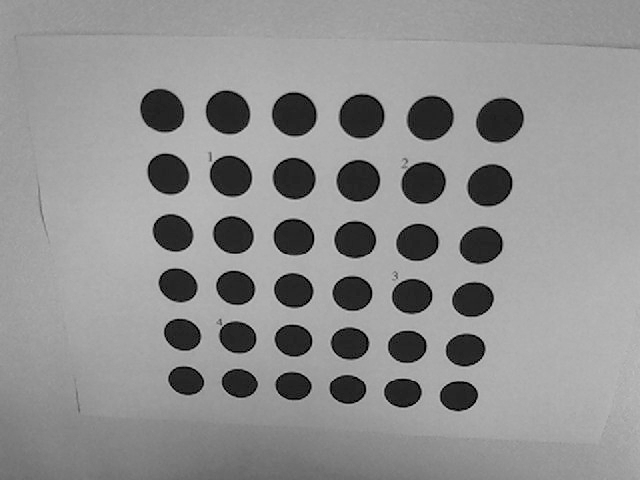
Input image
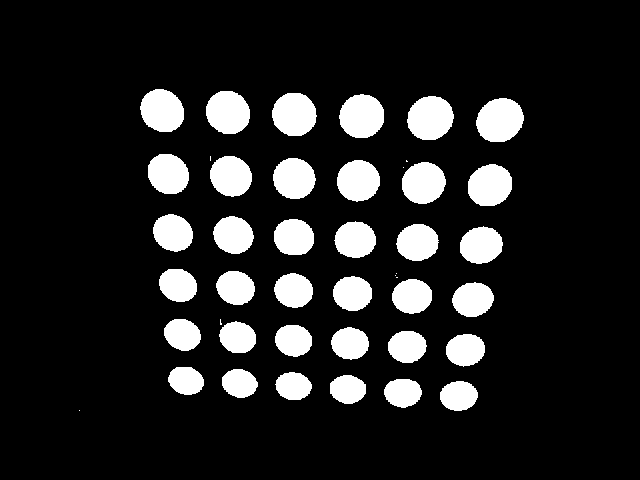
Image after binarization using the Otsu method
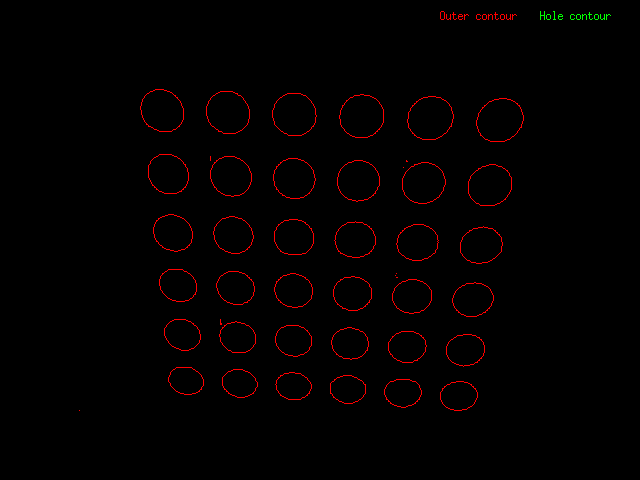
Contours extracted and displayed on a new image
To understand how the hierarchical contours extraction works, let's switch on another example. In a terminal, run:
$ ./tutorial-contour --input Contours_tree.pgm --white_foreground
The image after binarisation:

Image after binarization using the Otsu method
Instead of drawing all the contours with the same color, we can assign a first color for VISP_NAMESPACE_NAME::CONTOUR_OUTER contour and a second color for VISP_NAMESPACE_NAME::CONTOUR_HOLE contour.
The function to navigate in the contour tree is the following:
{
std::vector<std::vector<vpImagePoint> > contours;
for (std::vector<VISP_NAMESPACE_NAME::vpContour *>::const_iterator it = contour.
m_children.begin(); it != contour.
m_children.end();
++it) {
drawContoursTree(I, **it);
}
}
The call to draw the hierarchical contours:
drawContoursTree(I_draw_contours, vp_contours);
The result image is:
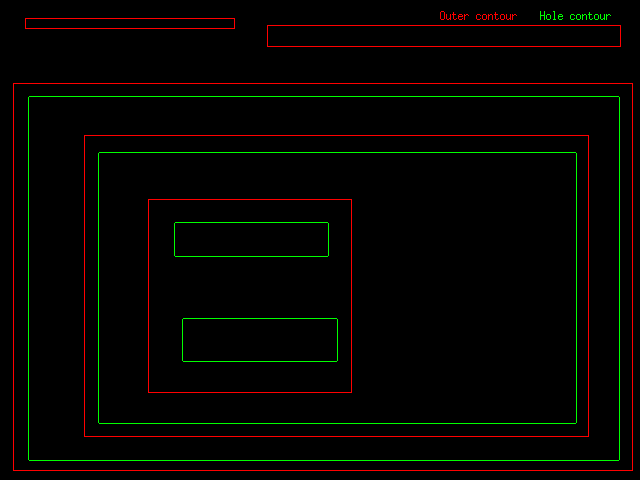
Contours extracted and displayed on a new image, in red outer contours, in green hole contours
To display the hierarchy, we can use this function:
{
std::cout << "\nContour:" << std::endl;
std::cout << "\tlevel: " << level << std::endl;
<< std::endl;
std::cout <<
"\tcontour size: " << contour.
m_points.size() << std::endl;
std::cout <<
"\tnb children: " << contour.
m_children.size() << std::endl;
for (std::vector<VISP_NAMESPACE_NAME::vpContour *>::const_iterator it = contour.
m_children.begin(); it != contour.
m_children.end();
++it) {
displayContourInfo(**it, level + 1);
}
}
For the VISP_NAMESPACE_NAME::CONTOUR_RETR_TREE method, the output is:
Contour:
level: 0
contour type: hole contour
contour size: 0
nb children: 3
Contour:
level: 1
contour type: outer contour
contour size: 438
nb children: 0
Contour:
level: 1
contour type: outer contour
contour size: 748
nb children: 0
Contour:
level: 1
contour type: outer contour
contour size: 2012
nb children: 1
Contour:
level: 2
contour type: hole contour
contour size: 1906
nb children: 1
Contour:
level: 3
contour type: outer contour
contour size: 1610
nb children: 1
Contour:
level: 4
contour type: hole contour
contour size: 1494
nb children: 1
Contour:
level: 5
contour type: outer contour
contour size: 792
nb children: 2
Contour:
level: 6
contour type: hole contour
contour size: 372
nb children: 0
Contour:
level: 6
contour type: hole contour
contour size: 392
nb children: 0
The top level contour is always the root contour with zero contour point and which contains the list of contours.
For the VISP_NAMESPACE_NAME::CONTOUR_RETR_EXTERNAL method, the output is:
Contour:
level: 0
contour type: hole contour
contour size: 0
nb children: 3
Contour:
level: 1
contour type: outer contour
contour size: 438
nb children: 0
Contour:
level: 1
contour type: outer contour
contour size: 748
nb children: 0
Contour:
level: 1
contour type: outer contour
contour size: 2012
nb children: 0
The result image is:
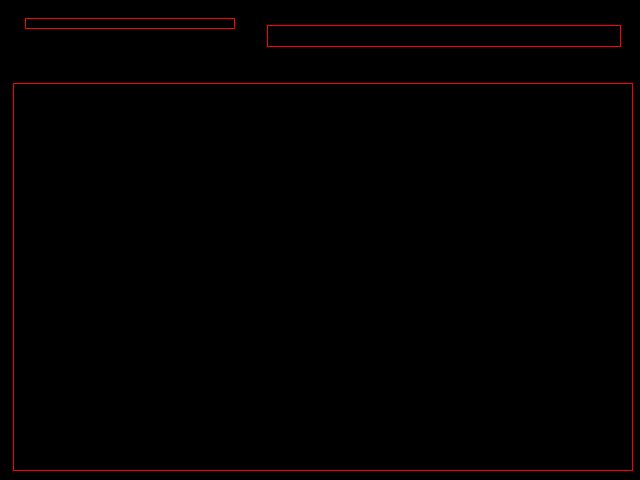
External contours extracted and displayed on a new image
For the VISP_NAMESPACE_NAME::CONTOUR_RETR_LIST method, the output is:
Contour:
level: 0
contour type: hole contour
contour size: 0
nb children: 9
Contour:
level: 1
contour type: outer contour
contour size: 438
nb children: 0
Contour:
level: 1
contour type: outer contour
contour size: 748
nb children: 0
Contour:
level: 1
contour type: outer contour
contour size: 2012
nb children: 0
Contour:
level: 1
contour type: hole contour
contour size: 1906
nb children: 0
Contour:
level: 1
contour type: outer contour
contour size: 1610
nb children: 0
Contour:
level: 1
contour type: hole contour
contour size: 1494
nb children: 0
Contour:
level: 1
contour type: outer contour
contour size: 792
nb children: 0
Contour:
level: 1
contour type: hole contour
contour size: 372
nb children: 0
Contour:
level: 1
contour type: hole contour
contour size: 392
nb children: 0
Next tutorial
You can now read the Tutorial: Connected-components labeling, for a similar method to extract the connected-components in a grayscale image.


![]()
![]()





